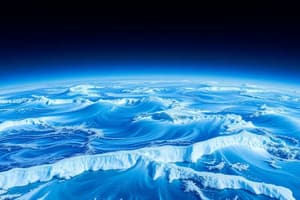Podcast
Questions and Answers
What is the surface layer of the ocean that extends to about 200m?
What is the surface layer of the ocean that extends to about 200m?
- Bathypelagic zone
- Abyssopelagic zone
- Epipelagic zone (correct)
- Mesopelagic zone
What is the Mesopelagic zone known as?
What is the Mesopelagic zone known as?
The twilight zone
What is the depth range of the Bathypelagic zone?
What is the depth range of the Bathypelagic zone?
1,000m-4,000m
What characterizes the Abyssopelagic zone?
What characterizes the Abyssopelagic zone?
What is found in the Hadopelagic zone?
What is found in the Hadopelagic zone?
What is the Ocean Surface?
What is the Ocean Surface?
What is an abyssal plain?
What is an abyssal plain?
What is a Mid-ocean Ridge?
What is a Mid-ocean Ridge?
What is the continental shelf?
What is the continental shelf?
What defines the continental slope?
What defines the continental slope?
What are trenches?
What are trenches?
What is a seamount?
What is a seamount?
What is a volcanic island?
What is a volcanic island?
What is a gyre?
What is a gyre?
What is a thermohaline current?
What is a thermohaline current?
What are waves in the ocean?
What are waves in the ocean?
What creates tides?
What creates tides?
What is upwelling?
What is upwelling?
Flashcards are hidden until you start studying
Study Notes
Ocean Zones
- Epipelagic Zone: The surface layer, extending to about 200 meters, where most ocean life is found due to sunlight penetration.
- Mesopelagic Zone: Known as the "twilight zone," this layer ranges from 200 to 1,000 meters and has limited light access.
- Bathypelagic Zone: Referred to as the "midnight zone," spanning 1,000 to 4,000 meters, characterized by darkness and cold temperatures.
- Abyssopelagic Zone: Known simply as the "Abyss," this zone ranges from 4,000 to 6,000 meters with no light and near-freezing temperatures.
- Hadopelagic Zone: The deepest zone starting from 6,000 meters, experiences extreme pressures of about 8 tons per square inch.
Ocean Features
- Ocean Surface: The area where wind interacts with water, creating waves and transferring energy.
- Abyssal Plain: A nearly flat and deep-sea floor section, providing a stable environment for diverse life forms.
- Mid-ocean Ridge: An undersea mountain chain formed at divergent plate boundaries, responsible for new ocean floor creation.
- Continental Shelf: Underwater land that extends from the continent, important for marine ecosystems and resources.
- Continental Slope: A steep incline marking the transition from continental crust to oceanic crust.
Deep Ocean Structures
- Trench: Extremely deep oceanic areas formed by subducting tectonic plates, often associated with tectonic activity.
- Seamount: An underwater volcanic mountain that rises from the ocean floor, which can support unique marine life.
- Volcanic Island: A volcanic mountain that reaches above sea level, formed through volcanic activity.
Ocean Currents and Movements
- Gyre: A massive rotating ocean current system that influences climate, where pollution can accumulate.
- Thermohaline Current: Deep-sea currents driven by variations in temperature and salinity, crucial for global ocean circulation.
- Waves: Generated by wind, they propagate energy across the ocean surface.
- Tides: Periodic rises and falls in sea level influenced by the moon's gravitational pull.
Nutrient Dynamics
- Upwelling: The process by which nutrient-rich, cold water rises to the surface, supporting marine life and ecosystems.
Studying That Suits You
Use AI to generate personalized quizzes and flashcards to suit your learning preferences.




